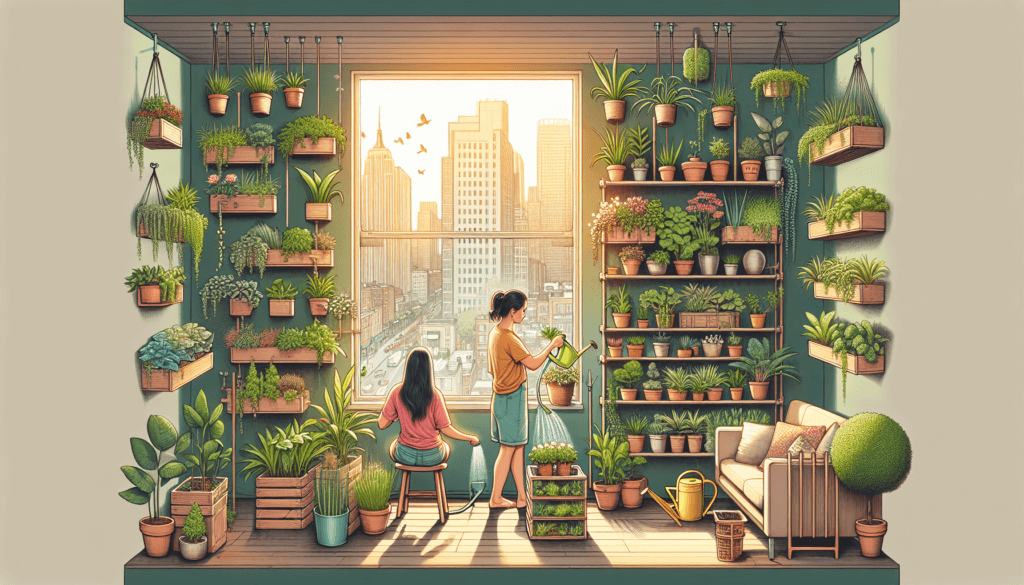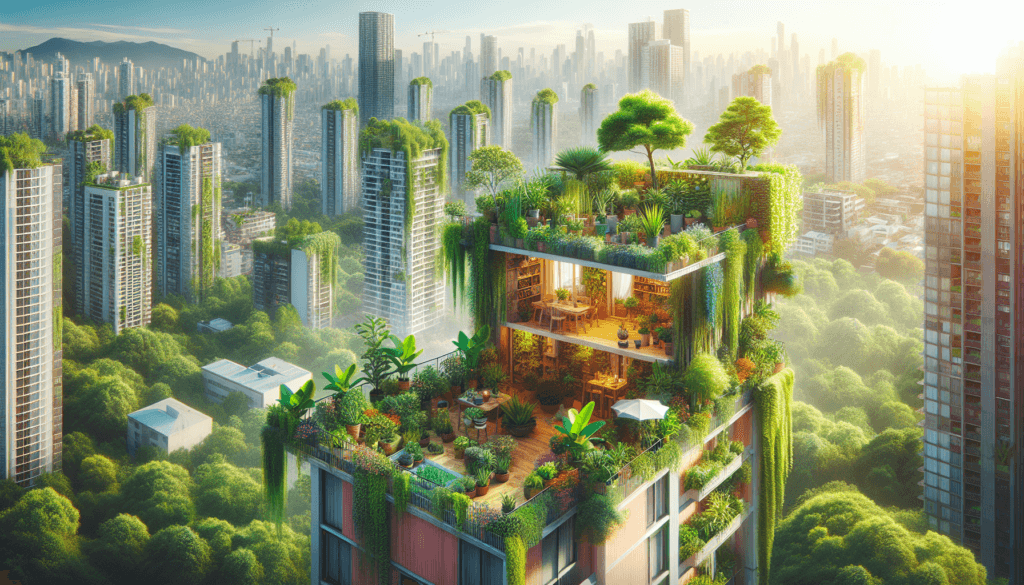Are you an apartment dweller who dreams of having a lush, green oasis right outside your window? Look no further! This article provides you with a comprehensive guide full of urban gardening tips tailored specifically for apartment dwellers. Whether you have a balcony, rooftop, or just a small window sill, these tips will help you transform your space into a thriving urban garden. Get ready to unleash your inner green thumb and create your own urban oasis in the concrete jungle!
Choosing the Right Plants
When it comes to urban gardening, one of the first things to consider is the available space. Since apartment living often means limited outdoor areas, it is important to choose plants that are suitable for indoor gardening. Look for plants that thrive in lower light conditions and are known for their adaptability to indoor environments.
Opting for compact and dwarf varieties is another smart choice. These types of plants take up less space and are perfect for small apartment gardens. Compact vegetables, such as cherry tomatoes and mini bell peppers, can be grown in containers on windowsills or balconies. Dwarf fruit trees, like citrus or fig trees, are also fantastic options for urban gardens as they can be easily grown in pots.
Lastly, consider the amount of sunlight that your apartment receives. Take note of the direction your windows face and assess the intensity and duration of sunlight throughout the day. This will help you determine which plants will thrive in the available light conditions. Some plants, like snake plants and pothos, can tolerate low light, while others, such as herbs and succulents, prefer bright, indirect sunlight.
Creating a Suitable Growing Environment
To ensure the success of your urban garden, it is important to create a suitable growing environment for your plants. Start by selecting the right containers. Choose pots or containers that have drainage holes to prevent waterlogging and root rot. Additionally, consider the material of the containers. Terra cotta is a popular choice as it allows for better airflow and allows excess moisture to evaporate.
Proper drainage is crucial for the health of your plants. Make sure that your pots or containers have drainage holes at the bottom to prevent water from pooling. Place saucers underneath the pots to catch excess water and prevent it from seeping onto your floors or furniture.
Using high-quality potting mix is essential for the overall health and growth of your plants. Look for a mix specifically formulated for indoor plants, as they often contain the right balance of nutrients and moisture retention properties. Avoid using garden soil, as it can be too heavy and may contain pests or diseases.
Adequate lighting is another important factor to consider in creating a suitable growing environment. While natural sunlight is ideal, it may not always be sufficient, especially in low-light apartments. In such cases, supplementing with artificial lighting like LED grow lights can ensure that your plants receive the light they need to thrive.
Maintaining optimal temperature and humidity levels is also crucial for the success of your indoor garden. Most plants prefer temperatures between 65°F to 75°F (18°C to 24°C). Avoid placing your plants near drafty windows or heating vents, as sudden temperature fluctuations can harm them. Additionally, some plants may benefit from increased humidity levels, especially during dry winter months. You can increase humidity by misting your plants with water and placing a tray of water near them.

Watering and Fertilizing Techniques
Watering your plants correctly is an important aspect of urban gardening. Determine the watering needs of each plant by researching their specific requirements. Some plants, like succulents, prefer infrequent watering, while others, like ferns, require more moisture. Avoid overwatering your plants as this can lead to root rot and other problems. Instead, water your plants when the top inch of the potting mix feels dry to the touch.
Establish a watering schedule that takes into account the specific needs of your plants. This will help you maintain a consistent watering routine and prevent under or overwatering. Use your finger or a moisture meter to check the moisture level of the potting mix before watering.
When it comes to fertilizing your plants, using organic fertilizers is a great choice. Organic fertilizers, such as compost or worm castings, provide slow-release nutrients that are gentle on your plants. Before applying any fertilizer, make sure to follow the recommended guidelines for the specific plant or fertilizer you are using. Overfertilizing can lead to nutrient burn and other negative effects on your plants’ health.
Pruning and Maintenance
Regularly inspecting your plants for pests and diseases is an important part of urban gardening. Pests, such as aphids or spider mites, can quickly spread and damage your plants if not detected early. Check the undersides of leaves, as pests often hide there. If you notice any signs of infestation, such as webbing or discolored leaves, take immediate action to prevent further damage.
Pruning is another essential maintenance practice for urban gardeners. Regularly prune your plants to promote growth and shape. This helps maintain a compact and neat appearance, especially for plants like herbs or shrubs. Remove any dead or yellowing leaves, as they can attract pests or indicate a health issue. Use clean and sharp pruning shears to make clean cuts and minimize damage to your plants.
For climbing or trailing plants, provide them with the necessary support to grow in a controlled manner. Install trellises or stakes to guide their growth and prevent them from sprawling all over your apartment. This not only helps save space but also adds a decorative element to your indoor garden.
Regularly cleaning and dusting your plants is not just for aesthetic purposes. Dust can block sunlight and hinder photosynthesis, so gently wipe the leaves with a damp cloth or sponge to keep them clean and dust-free. This will ensure that your plants can efficiently absorb light and nutrients.

Maximizing Limited Space
For apartment dwellers, maximizing limited space is essential in creating a thriving urban garden. Utilize vertical gardening techniques to make the most of your available space. Install wall-mounted planters or hanging baskets to grow plants vertically, saving space on countertops or floors. Vertical gardening not only adds a unique design element but also promotes better air circulation and sunlight exposure for your plants.
Another space-saving option is to hang plants or create a plant wall. Use sturdy hooks or hanging planters to suspend plants from ceilings or walls. This is especially beneficial for trailing plants like ivy or pothos, as it allows them to cascade down and create a beautiful visual effect.
Arrange plants strategically for better access and organization. Group plants with similar light and watering requirements together, making it easier for you to care for them. Place taller plants towards the back or corners of your apartment, and smaller plants towards the front or edges. This creates a visually appealing display while maximizing space.
Utilize windowsills and balconies to their fullest potential. These areas often receive the most sunlight, making them perfect for growing sun-loving plants like herbs or flowering plants. Use window boxes or railing planters to add greenery and make the most of the available outdoor space.
Consider using plant stands or shelves to create additional levels and display your plants in a visually appealing way. This allows you to showcase more plants without taking up precious floor space. Choose stands or shelves that match your décor and provide adequate stability for your plants.
Managing Pests and Diseases
Indoor plants are not immune to pests and diseases, so it’s important to be vigilant and take preventive measures. Learn to identify common indoor plant pests like aphids, mealybugs, or scale insects. Regularly inspect your plants for signs of infestation, such as distorted leaves or sticky residue.
Prevent and control pests with natural remedies whenever possible. Options include homemade insecticidal soap sprays, neem oil, or introducing beneficial insects like ladybugs or predatory mites. These methods are environmentally friendly and safe for your plants, ensuring that your indoor garden remains pest-free.
Regularly inspect your plants for signs of diseases such as leaf spots or fungal infections. Catching diseases early can prevent further spread and damage to your plants. If you notice any signs of disease, immediately isolate the affected plant and treat it with appropriate remedies, which may include antifungal sprays or removing infected parts.
Maintain clean and sanitized gardening tools to prevent the spread of pests and diseases. Clean your tools after every use with a mixture of bleach and water or rubbing alcohol. This simple step can help prevent the transmission of harmful pathogens from plant to plant.

Harvesting and Using Homegrown Produce
One of the most rewarding aspects of urban gardening is being able to harvest and enjoy your own homegrown produce. Knowing when to harvest each plant is crucial to enjoy the best flavor and texture. Research specific harvesting guidelines for each plant, as it varies depending on the type and variety.
When it’s time to harvest, handle your produce with care to avoid damage. Use sharp and clean gardening shears or scissors to cut fruits, vegetables, or herbs. This prevents bruising or crushing, which can affect the quality and shelf life of your harvest.
After harvesting, store your produce properly to preserve freshness. Some vegetables, like tomatoes or peppers, can be stored at room temperature, while others, like leafy greens or herbs, are best stored in the refrigerator. Proper storage ensures that your homegrown produce stays fresh and delicious for longer.
Make the most of your homegrown herbs and vegetables by incorporating them into your cooking. Use fresh basil in pasta dishes, mint in refreshing drinks, or cherry tomatoes in salads. The flavors and aromas of freshly harvested produce can elevate your culinary creations.
Explore preservation techniques to extend the shelf life of your harvest. Consider drying herbs for later use, freezing fruits or vegetables, or making homemade jams and preserves. Preserving your homegrown produce allows you to enjoy the bounty of your garden even during the colder months.
Creating a Relaxing Outdoor Environment
Having an urban garden goes beyond just growing plants; it’s about creating a relaxing outdoor environment where you can unwind and enjoy nature. Add decorative elements to your garden, such as garden gnomes, wind chimes, or colorful planters. These elements add personality and charm to your space, making it a truly unique oasis.
Create seating areas for relaxation. Place a comfortable chair or bench in a shaded spot where you can enjoy your garden. Adding cushions or outdoor pillows creates a cozy and inviting atmosphere. This space can become your personal sanctuary, where you can read a book, sip your morning coffee, or simply take in the beauty of your garden.
Incorporate water features or mini fountains to create a soothing ambiance. The sound of trickling water can provide a sense of tranquility and drown out the noise of the city. Place a small tabletop fountain or install a wall-mounted water feature to add a touch of serenity to your outdoor space.
Use mood lighting to enhance the ambiance of your garden. String fairy lights or install solar-powered lanterns to create a warm and inviting atmosphere. Lighting your space in the evening allows you to enjoy your garden even after the sun sets, adding a magical touch to your urban oasis.
To create a cozy and inviting atmosphere, incorporate outdoor textiles like rugs or throws. These can add warmth and comfort to your seating areas, making them even more inviting. Choose fabrics that are weather-resistant and easy to clean to ensure they withstand the elements.

Joining Community Gardens and Organizations
Being part of a gardening community offers numerous benefits for apartment dwellers. Research community garden options in your area, as many cities have communal garden spaces where you can rent a plot to grow your own plants. Community gardens provide a sense of camaraderie and allow you to learn from experienced gardeners.
Get involved in local gardening organizations or clubs. These groups often organize workshops, plant exchanges, or group gardening projects. Connecting with fellow gardeners who share your passion can be inspiring and provide valuable knowledge and tips.
Participate in gardening workshops or events. Many gardening centers, nurseries, or botanical gardens offer classes on various topics, from plant care to landscaping. Attending these workshops allows you to learn new skills and expand your gardening knowledge.
Exchange tips and experiences with fellow gardeners. Whether it’s through online gardening forums or local gardening groups, sharing your successes and challenges with others can be immensely helpful. You can gain insights, troubleshoot problems, or simply find support and encouragement from like-minded individuals.
Contribute to urban greening initiatives. Many cities have urban greening projects aimed at increasing green spaces and improving the environment. Get involved by volunteering your time or resources to such initiatives. By participating in these programs, you not only contribute to the beautification of your city but also promote sustainability and a greener future.
Seeking Professional Assistance
Sometimes, seeking professional assistance is the best option to ensure the success of your urban garden. Consult with local plant nurseries or garden centers for expert advice. The staff can guide you in choosing the right plants for your space, recommend suitable containers and soil, and provide valuable tips for plant care.
Consider hiring a professional gardener or landscaper if you feel overwhelmed or lack the time to maintain your garden. They can help with tasks like pruning, fertilizing, or designing your outdoor space. Hiring a professional ensures that your garden receives the care and attention it needs, even when you’re busy or away.
Explore online resources and gardening forums. The internet is a treasure trove of gardening information, from plant care guides to troubleshooting tips. Websites and forums dedicated to gardening can provide answers to your questions and offer inspiration for your urban garden.
Attend gardening classes or courses. Many botanical gardens or horticultural institutions offer courses for all skill levels. These classes provide in-depth knowledge and hands-on experience, allowing you to become a more confident and knowledgeable gardener. Whether you’re a beginner or an experienced gardener, there is always something new to learn.
Invest in helpful gardening tools and equipment. Having the right tools can make gardening easier and more enjoyable. Prioritize purchasing essential items like a trowel, pruning shears, watering cans, and gardening gloves. Quality tools will last longer and provide better results, saving you time and effort in the long run.
By following these urban gardening tips and guidelines, you can transform your apartment into a green oasis. With proper plant selection, a suitable growing environment, and regular maintenance, you can enjoy the beauty of nature right in your own home. Making the most of limited space, managing pests and diseases, and exploring creative ways to use your homegrown produce will further enhance your urban gardening experience. So grab your gardening tools and get ready to create a thriving, relaxing, and rewarding urban garden!


